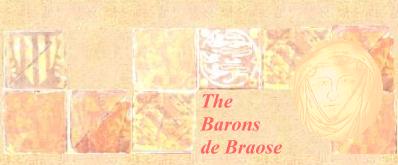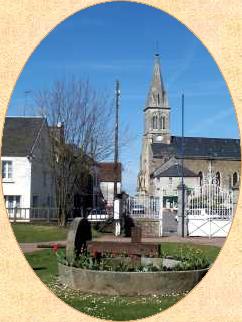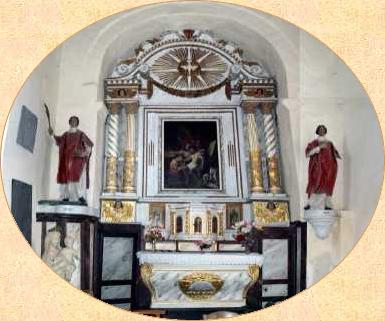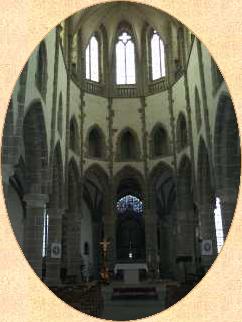
Briouze
In 1073 William de Braose
joined the Conqueror in a campaign to subdue Maine, which had
rebelled against its Norman masters. Maine's principal city,
Le Mans had taken the bold step of declaring itself a commune.
The Duke of Anjou claimed lordship over Maine, which was acknowledged
by King William who nevertheless wanted to impose his son Robert
as its ruler.
 Briouze Castle held a strategic position on the
Norman borders with Maine, Brittany and the lands of Anjou. It
was the second line of defence after the powerfully fortified
castle of Domfront. The status of the de Braose family at this
time can be measured by the importance of Domfront. William the
Conqueror gained it from Geoffrey Martel, Duke of Anjou in 1055
and Domfront's fortifications were strengthened by successive
dukes and kings. It was defended and attacked by the most powerful
men of the eleventh and twelfth centuries. This in turn gave
Briouze a major role in Normandy's defences.
Briouze Castle held a strategic position on the
Norman borders with Maine, Brittany and the lands of Anjou. It
was the second line of defence after the powerfully fortified
castle of Domfront. The status of the de Braose family at this
time can be measured by the importance of Domfront. William the
Conqueror gained it from Geoffrey Martel, Duke of Anjou in 1055
and Domfront's fortifications were strengthened by successive
dukes and kings. It was defended and attacked by the most powerful
men of the eleventh and twelfth centuries. This in turn gave
Briouze a major role in Normandy's defences.
English
wealth was flowing back to Normandy and William de Braose was
quick to enrich his church
at Briouze. He
first offered the church and its endowments to the nearby Abbey
of Lonlay which, to his dismay, abandoned Briouze soon afterwards.
The Abbot refused to accept the conditions of the grant and Lonlay
lost a valuable benefactor.
William then gave the church
to his mother, Gunnor, who presumably relinquished it when she
became a nun at the Abbaye aux Dames in Caen. Secular canons
were invited to form a college, as at Saint Nicholas Church in
Bramber, but by 1080 a scandal had come to light. The canons
were found to be leading wicked lives and William ejected them.

Soon the monk Goscelm from
the Benedictine Abbey of Saint Florent in Saumur, Anjou had begun
building a new stone church at Briouze. His great toil won the
appreciation of William de Braose, who had been disappointed
by earlier failures. He had probably visited the Abbey of Saint
Florent and admired it during the Conqueror's campaign in Maine.
On Friday, January 31,
1080 the King confirmed William de Braose's grant of the church
of Briouze to Saint Florent. It was to become a priory financed
with gifts from the de Braose lands in Normandy and the Rape
of Bramber. (3.1) Unlike the Abbot of Lonlay, the
Abbot of Saint Florent agreed to William de Braose's condition
that should the new priory prosper, it would one day become an
abbey. (Sadly, it never did.)
By 1080 Lonlay Abbey
realised that it had rejected the gifts of a very wealthy man.
Abbot Hugh of Lonlay took a case to William the Conqueror's court
at Caen, claiming that William de Braose had broken his solemn
promise to make the gift of his lands to Lonlay. The Abbot failed
to impress the King and lost the case, but the grievance was
not forgotten. (3.2)
In 1093 Abbot Ranulf of
Lonlay revived the case and took it to Robert Duke of Normandy,
the Conqueror's son, hoping perhaps that William de Braose was
not in his favour. The Duke was holding an important Council
at Bonneville. William de Braose and the monks of Saint Florent
put their case and gave evidence to show the dishonesty and greed
of the claims made by Lonlay. Abbot Ranulf and his monks made
a hasty retreat, disappearing without informing the Duke. This
infuriated Robert. He demanded that Lonlay make compensation
to Saint Florent for its wasted time at Court defending a false
claim.(3.3)
Shortly afterwards William
de Braose's priory church at Briouze was dedicated to the fourth
century martyrs, Saints Gervais and Protais. On Sunday, December
11, 1093 a dedication ceremony was attended by Serlo, Bishop
of Sées, and other clergy, barons and witnesses. It was
a dramatic scene.
The Bishop was just about
to celebrate Mass at the altar when William de Braose forced
his unwilling son Philip to confirm the grants to Saint Florent
in the sight of all present. We don't know the reason for Philip's
reluctance. William de Braose was assisted by his nephew, William
de Crenella. They took a dagger from a monk named Armellus and
placed it on the altar. While the family gifts to Saint Florent
were recited at William de Braose's command, all three placed
their hands on the dagger to confirm their solemn oath.(3.4)

back to text

back to text

back
to text
English wealth was flowing back to Normandy and William de Braose was quick to enrich his church at Briouze. He first offered the church and its endowments to the nearby Abbey of Lonlay which, to his dismay, abandoned Briouze soon afterwards. The Abbot refused to accept the conditions of the grant and Lonlay lost a valuable benefactor. William then gave the church
to his mother, Gunnor, who presumably relinquished it when she
became a nun at the Abbaye aux Dames in Caen. Secular canons
were invited to form a college, as at Saint Nicholas Church in
Bramber, but by 1080 a scandal had come to light. The canons
were found to be leading wicked lives and William ejected them.
Soon the monk Goscelm from the Benedictine Abbey of Saint Florent in Saumur, Anjou had begun building a new stone church at Briouze. His great toil won the appreciation of William de Braose, who had been disappointed by earlier failures. He had probably visited the Abbey of Saint Florent and admired it during the Conqueror's campaign in Maine. On Friday, January 31, 1080 the King confirmed William de Braose's grant of the church of Briouze to Saint Florent. It was to become a priory financed with gifts from the de Braose lands in Normandy and the Rape of Bramber. (3.1) Unlike the Abbot of Lonlay, the Abbot of Saint Florent agreed to William de Braose's condition that should the new priory prosper, it would one day become an abbey. (Sadly, it never did.) By 1080 Lonlay Abbey
realised that it had rejected the gifts of a very wealthy man.
Abbot Hugh of Lonlay took a case to William the Conqueror's court
at Caen, claiming that William de Braose had broken his solemn
promise to make the gift of his lands to Lonlay. The Abbot failed
to impress the King and lost the case, but the grievance was
not forgotten. (3.2) In 1093 Abbot Ranulf of Lonlay revived the case and took it to Robert Duke of Normandy, the Conqueror's son, hoping perhaps that William de Braose was not in his favour. The Duke was holding an important Council at Bonneville. William de Braose and the monks of Saint Florent put their case and gave evidence to show the dishonesty and greed of the claims made by Lonlay. Abbot Ranulf and his monks made a hasty retreat, disappearing without informing the Duke. This infuriated Robert. He demanded that Lonlay make compensation to Saint Florent for its wasted time at Court defending a false claim.(3.3) Shortly afterwards William de Braose's priory church at Briouze was dedicated to the fourth century martyrs, Saints Gervais and Protais. On Sunday, December 11, 1093 a dedication ceremony was attended by Serlo, Bishop of Sées, and other clergy, barons and witnesses. It was a dramatic scene. The Bishop was just about
to celebrate Mass at the altar when William de Braose forced
his unwilling son Philip to confirm the grants to Saint Florent
in the sight of all present. We don't know the reason for Philip's
reluctance. William de Braose was assisted by his nephew, William
de Crenella. They took a dagger from a monk named Armellus and
placed it on the altar. While the family gifts to Saint Florent
were recited at William de Braose's command, all three placed
their hands on the dagger to confirm their solemn oath.(3.4)
|